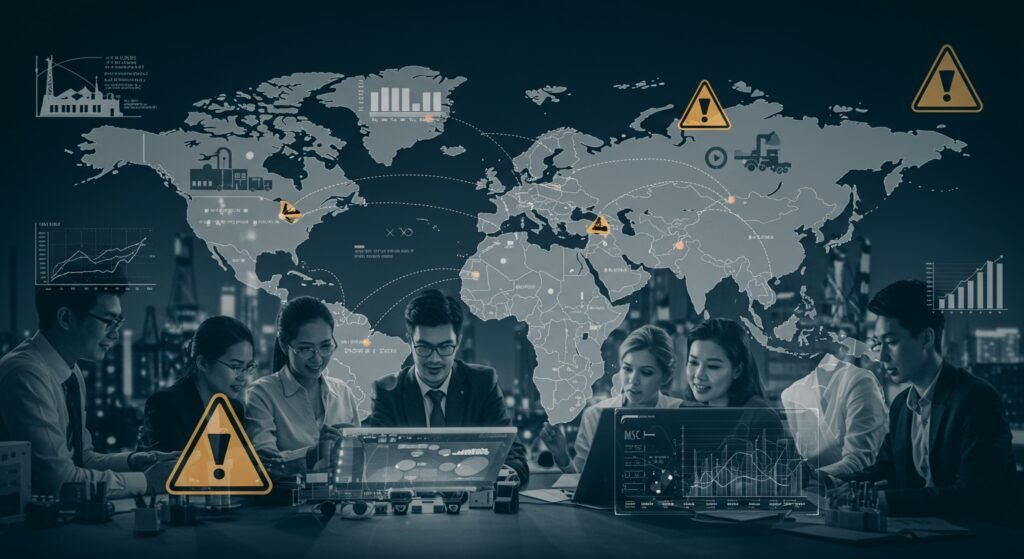For aspiring professionals pursuing an MSc in Supply Chain Management, mastering risk management is not just an academic exercise; it’s a critical skill for navigating today’s volatile global economy. The interconnectedness of modern supply chains, coupled with geopolitical instability, natural disasters, and technological disruptions, makes robust risk mitigation indispensable. This article delves into the core principles of global supply chain risk management, offering MSc students a strategic framework to build resilience and ensure continuity in complex operational environments.
- Introduction
- Understanding Global Supply Chain Risk Management
- What is Supply Chain Risk?
- The Evolving Landscape of Global Supply Chains
- Key Strategies for Effective Risk Management
- Risk Identification and Assessment
- Mitigation and Contingency Planning
- Building Supply Chain Resilience
- Leveraging Technology and Data Analytics
- The Role of an SCM Graduate in Risk Mitigation
- Conclusion
Understanding Global Supply Chain Risk Management
What is Supply Chain Risk?
Supply chain risk refers to any event or factor that has the potential to disrupt the flow of goods and services from source to customer, impacting financial performance, operational efficiency, and reputation. These risks can stem from various sources, including natural events (earthquakes, pandemics), geopolitical shifts (trade wars, sanctions), economic fluctuations (recessions, inflation), technological failures (cyberattacks, system outages), and operational challenges (supplier insolvency, quality control issues). For an SCM graduate, understanding the multifaceted nature of these risks is the first step towards developing effective counter-strategies.
The Evolving Landscape of Global Supply Chains
Historically, supply chains optimized for cost and efficiency. However, recent events, such as the COVID-19 pandemic, the Suez Canal blockage, and persistent geopolitical tensions, have exposed the fragility of these lean systems. The shift is now towards building supply chain resilience, emphasizing adaptability, visibility, and responsiveness. Global supply chains are inherently complex, involving multiple tiers of suppliers, diverse geographical locations, and intricate logistics networks. This complexity amplifies the potential for disruptions, making proactive risk management more crucial than ever for future leaders in the field.
Key Strategies for Effective Risk Management
Risk Identification and Assessment
The initial phase of any robust risk management framework involves identifying potential risks across the entire supply chain. This requires a comprehensive mapping of all suppliers, production sites, distribution channels, and logistics partners. Once identified, risks must be assessed based on their likelihood of occurrence and potential impact. Techniques such as FMEA (Failure Mode and Effects Analysis) or quantitative risk modeling can be employed to prioritize risks, allowing organizations to focus resources where they are most needed.
Mitigation and Contingency Planning
After risks are identified and assessed, the next step is to develop strategies to mitigate their impact. Mitigation might involve diversifying the supplier base, holding safety stock, investing in robust cybersecurity, or redesigning processes to reduce single points of failure. Contingency plans, on the other hand, are prepared responses for when a risk event actually occurs. These plans outline immediate actions, communication protocols, and alternative operational procedures to minimize disruption. For instance, having alternative transportation routes or backup manufacturing facilities are common contingency measures.
Building Supply Chain Resilience
Resilience goes beyond merely recovering from disruptions; it’s about building the inherent capacity of a supply chain to absorb, adapt to, and recover from disturbances while maintaining essential operations. This includes fostering strong supplier relationships, enhancing supply chain visibility through data sharing, and promoting agility in decision-making. Companies like SupplyChainBrain regularly publish insights on building resilient supply networks.
Leveraging Technology and Data Analytics
Modern technology plays a pivotal role in advanced risk management. Predictive analytics, AI, machine learning, and blockchain can provide unprecedented visibility into supply chain operations, enabling early warning systems for potential disruptions. Real-time data from IoT devices can monitor inventory levels, shipment progress, and environmental conditions. For more insights on digital transformation, refer to our article on Digital Transformation in Logistics. These tools empower organizations and future MSc students to make data-driven decisions, anticipate threats, and respond with greater speed and precision.
| Risk Type | Example Event | Mitigation Strategy | Contingency Plan |
|---|---|---|---|
| Geopolitical | Trade tariffs, sanctions | Diversify sourcing geographically | Shift production to compliant regions |
| Natural Disaster | Earthquake, flood | Multiple production sites, inventory buffers | Emergency supplier activation, alternative logistics |
| Cyberattack | Data breach, system downtime | Robust cybersecurity, employee training | Offline backups, incident response team |
| Supplier Failure | Bankruptcy, quality issues | Multi-sourcing, supplier audits, contract clauses | Pre-qualified backup suppliers, insourcing options |
| Demand Fluctuation | Sudden market shift | Flexible production, agile inventory management | Dynamic pricing, promotional campaigns |
The Role of an SCM Graduate in Risk Mitigation
As an SCM graduate, you will be expected to not only understand these strategies but also to implement and adapt them within diverse organizational contexts. Your education in global supply chain risk management will equip you with the analytical tools to conduct thorough risk assessments, the strategic thinking to develop effective mitigation plans, and the leadership skills to drive cultural change towards greater resilience. The demand for professionals who can safeguard supply chains against future shocks is rapidly growing, making this a highly sought-after specialization.
Conclusion
The landscape of global commerce is more unpredictable than ever, making global supply chain risk management an indispensable competency for any aspiring SCM professional. By understanding the nature of supply chain risks, embracing proactive strategies for identification and mitigation, and leveraging technological advancements, MSc students can position themselves as invaluable assets to organizations worldwide. Building resilient supply chains is not merely about avoiding losses; it’s about fostering sustainable growth and competitive advantage in a complex and ever-changing world.


